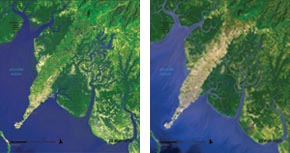A United Nations report documents how the continent’s natural landscape has been severely degraded over the past several decades by rapid population growth, global warming, drought, deforestation, and expanding agriculture. Entitled Africa: Atlas of Our Changing Environment, the 400-page report uses more than 300 satellite images to document the human impact on the natural world, including deforestation in northern Congo, Madagascar, and many other countries; the shrinking of numerous lakes, such as Lake Chad, from irrigation and desertification; the rapid retreat of tropical glaciers on mountains such as Kilimanjaro; and the explosive growth of urban centers such as Cairo and the Senegalese capital of Dakar. The report by the U.N. Environment Programme said Africa is losing more than 4 million hectares (9.9 million acres) of forest annually, an area equivalent to Switzerland, and that deforestation is a major concern in 35 African countries. Not all the news in the report is grim, however, with UNEP citing cases of successful restoration of forests, wetlands, and grazing lands.
The image below, left, shows Conakry, the capital of Guinea, in 1975. The image at right shows Conakry in 2007 after a burgeoning population expanded northwards into large swaths of wetlands and woodlands.

The image below, left, shows Conakry, the capital of Guinea, in 1975. The image at right shows Conakry in 2007 after a burgeoning population expanded northwards into large swaths of wetlands and woodlands.

United Nations Environment Programme